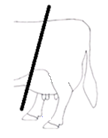Cleanliness
Why is it measured?
Areas of dirt (faeces/mud) within different regions of the cow’s body are as a result of different causes and can affect welfare in different ways. In general, if given the choice, cows will choose to lie in clean dry areas. Dirtiness on the coat can irritate the skin, provide optimal conditions for ectoparatsites, increase cold stress, indicate dirty lying areas or lack of grooming facilities (brushes, trees etc.), increase the risk of disease and cause issues at or prior to slaughter.
The lower legs: A high level of dirtiness in this region is associated with increased risk of lameness, digital dermatitis, interdigital dermatitis, slurry heal and mastitis. It can also obscure skin damage and foot lesions preventing early detection, treatment and increasing recovery times. It can be caused by poor slurry systems, lack of bedding, overstocking, or poached paddocks.
The hind quarters: Dirtiness in this region may be as a result of incorrect feeding, change in feeding, lush grass, endoparasites, infectious disease or dirty environments (lack of bedding, poor cubicle maintenance, overstocking etc.)
The udder & teats: Dirtiness in this region can be caused by anything listed above. Dirt on the udder is strongly associated with the development of mastitis, increases the pre-milking cleaning (which adds time to the milking routine) and increases the risk of poor milk quality.
How to assess and score using the AssureWel measure
| 3. Cleanliness Individual measure |
Sample: 20 cows selected at random (3 or more assessed jointly with stockperson)
Visually assess the one randomly selected side of the animal and behind, only including the hind quarters to coronary band and udder: |
 |
| Scoring: |
0 = Clean
No dirt or only minor splashing present
2 = Very Dirty
An area of dirtiness (i.e. layer or plaques of dirt) amounting to at least forearm length (40cm) in any dimension.
|
| |
|
 |
- Mobility
- Body condition
- Cleanliness
- Hair loss, lesions
- Swellings
- Broken tails
- Response to stockperson
- Cows needing further care
- Mastitis
- Calf/Heifer survivability
- Cull and Casualty Cows